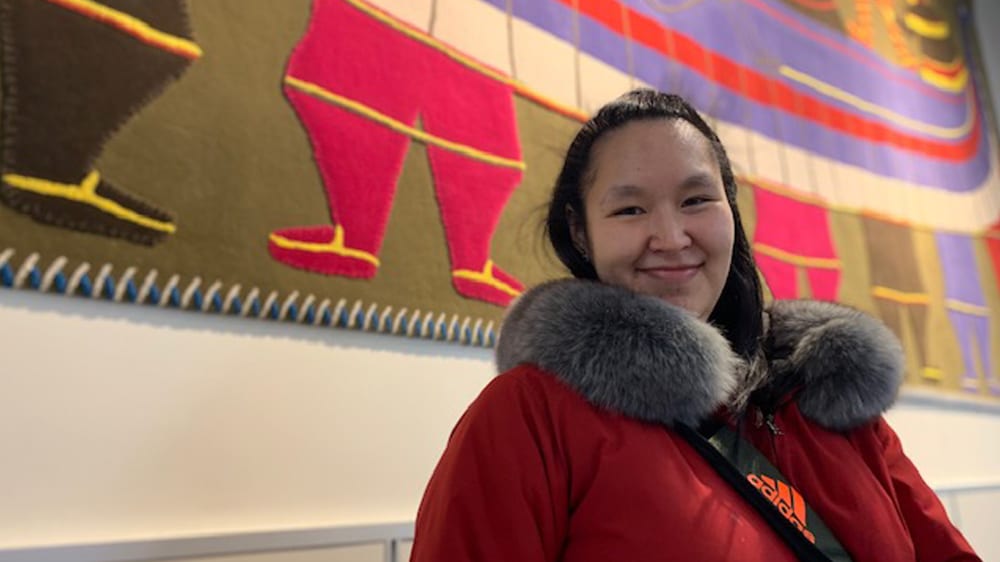
The cover of the New York Times article on Cape Dorset. The story has upset Ooloosie Saila, one of the artists in the story.
Ooloosie Saila sits at Gate 5 of the Iqaluit International Airport waiting to board a flight back to her home town of Cape Dorset, Nunavut.
In her hands, a Northmart bag filled with things to bring home, including a remote control ATV for her young son.
The same young son used as a narrative device by New York Times (NYT) author Catherine Porter in her story Drawn From Poverty: Art Was Supposed To Save Canada’s Inuit.
The article was called “harmful to Inuit” and “laced with clichés” by the Native American Journalists Association (NAJA).
The story starts with Saila and her boys fleeing a home at night, and ends with him wistfully hoping to get a bicycle.
NAJA called for an audit of the New York Times story, demanded an apology and offered to meet with the editorial team responsible for the story.
That meeting happened on Nov. 11.
According to APTN News producer and NAJA board member Francine Compton, the NYT said the article was approved by Saila before publishing.
Saila says that didn’t happen.
“Catherine, she didn’t even send me pictures,” says Saila.
APTN requested an interview with the New York Times and reporter Catherine Porter but received a statement instead.
“We have welcomed the Native American Journalists Association’s offer to meet with The New York Times on the article or any other issue and in fact have already spoken with them on these issues since the publication of the story,” the statement from Ari Isaacman Bevacqua, director of communications for The New York Times said.
“Our correspondent Catherine Porter spent weeks in Cape Dorset for the specific purpose of finding out and understanding what life is like for the people there. The issues that we recount came up repeatedly in the lives of the people we interviewed and profiled. They were frequently raised by members of the Cape Dorset community as significant, persistent challenges they wanted solved.
“The article also includes positives about Cape Dorset: the significant successes of the co-op that is a hub in the community, the local culture of sharing and the artistic achievements of the people in the story.”
While Saila says she did hear from Porter before the story came out, she didn’t receive a full copy prior to publication.
“They were talking but they didn’t tell me exactly what the words were saying,” she says.
Like many Inuit from Nunavut’s smaller communities, Inuktitut is Saila’s first language.
She speaks English fluently, but with pauses.
This is very common in Nunavut. Inuktitut’s sentence structure is the opposite of English. What would come first in English comes last in Inuktitut. So to speak English, first she has to translate in her mind, then reverse the order of the thoughts. That takes time, and can make English nuance hard to capture.
She did speak with Porter after publication, and says Porter tried to explain how she could see the story as a positive.
“She was saying that my artwork, will sell faster. She was saying that she was trying to help me,” says Saila.
APTN asked if the story helped her.
“No,” she says.
Saila was wondering how it was supposed to sell her art, when her art is barely a part of the story.
“My prints didn’t even showing on the newspaper. Only one picture is showing, on the front page, when I was in Toronto,” she explains.
Porter’s tale begins with Saila “cowering in fear” as a “relative who was drunk and raging – again” was in the next room, before she “fled into the frigid night.”
While it might make for a gripping narrative, it doesn’t account for Saila having to return to that home afterwards.
“I didn’t want the drunk part on the newspapers, but it was on the newspapers, and about the poverty, saying that my family are poor or something. I’m not poor, I didn’t even say anything about poverty, but she put it on the newspapers.” explains Saila.
Like NAJA describes, the clichés come fast and furious in “Drawn From Poverty”. “Fume sniffing teenagers”, “The stony graveyard is dotted with crosses”, “Her next stop was the welfare office”, the clichés are colourful, but don’t describe the whole story.
Take for example, “children rode their bikes in packs around the town’s now-dusty roads well past bedtime.”
When the sun is out for almost 24 hours, and it isn’t a school night, what is bedtime in a small Nunavut community?
Kids playing late is a feature of a Nunavut summer, because it’s tough to play outside in the winter with little sunlight.
The story even claims there is “no downtown” in Cape Dorset.
There is a downtown Cape Dorset, you can find it right outside the Co-op, across the street from the Arctic College office, near one hotel and down the hill from the other.
For her part, Saila is going to keep working on her stunning art, which is what caught the attention of the New York Times in the first place. But the next time a reporter comes calling, she is going to be more careful.
“I learned a lot, what I say and what not to say,” explains Saila, as she makes her way to board the plane back home.
@kentdriscoll











I am sympathetic to many of the concerns of Saila and the community, but in finally reading the story (I had to with all the continued critiques!) I don’t think the author ever used the word “poverty” or “poor” to describe Saila. She does paint a picture of poverty in the community, which is likely true if not very eloquently worded, and mentions that Saila has struggles, but does better than most locals. I sort of wonder if Saila is being used a bit, caught in the middle of a cultural struggle between her community, Inuit activists, and an elite media behemoth from down south. It’s unfortunate all around, but I hope Saila does see some benefit from the story. Her pictures are prominent on the web version, as is a link to her art sales site. If I had the money I would certainly try to buy one.
straight talk
the reporter should of stayed home and told that story had played in there office for many years by others. They don’t listen to what the people have to say. next time stay home and live in your fantasy worlds eh.